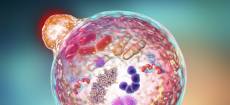

Autophagy
What is autophagy?
Autophagy is a ‘self-eating’ process that involves the breakdown of cellular contents for various purposes. Ammonia is a key regulator of autophagy. We can essentially consider it as a ‘detox process,’ it is highly conserved in eukaryotes.
Why do cells use autophagy?
A cell needs energy and metabolites. Autophagy can provide amino acids, nucleotides, sugars under low nutrient conditions. Autophagy has a role to play in cell differentiation and development. Lastly, it removes aggregates, damaged organelles (parts of cells) and invading pathogens.
Who participates in carrying out autophagy?
Lysosomes are the central organelles for cellular degradation as they are low pH compartments containing hydrolytic enzymes. We also need the formation of a double membrane structure called the autophagosome.
Different types of autophagy:
Microautophagy: the lysosome takes up contents within its vicinity
Chaperone-mediated autophagy: is more specific. Proteins with the KFERQ motif are taken by Hsp70 chaperone to the lamp-2A receptor on the lysosome membrane. Binding of protein causes the lamp-2A receptor to dimerise and the protein is translocated (transported) across the membrane into the lysosome to be broken down.
Xenophagy: breakdown of toxic substances within the cell
Mitophagy/ Pexophagy/ reticulophagy: breakdown of organelles
Macroautophagy: breakdown of cellular contents
What is the origin of the autophagosome?
The autophagosome comes from various places such as the mitochondria, early and late endosomes, golgi apparatus and the plasma membrane.
How does the autophagosome form?
MTORC1 complex is a nutrient sensor that when nutrient supply is sufficient, the complex inhibits autophagy. In times of nutrient starvation, MTORC1 is inactivated. ULK1 is activated and phosphorylates Class III PI3K which is involved in the synthesis of phospholipid. Other proteins are recruited in the formation of the isolation membrane. Formation of the autophagosome requires Atg genes and LC3 complexes, LC3 also has an important role in cargo loading.
Is autophagy selective or non-selective?
Both. The autophagosome does not exhibit specificity therefore selective autophagy requires adaptor proteins. P62 also called sequestosome 1 is a ubiquitin binding protein that targets proteins for selective autophagy. Sequestosome 1 is recognised by sequestosome 1-like receptors on the isolation membrane.
What happens if autophagy is defective?
Apoptosis (programmed cell death)
Nrf2 hyperactivation of bZIP
ROS release (reactive oxygen species) from damaged mitochondria
Aggregate formation
Chronic infection if pathogen is not destroyed
Defective autophagy has implications for human health. It can lead to Parkinson’s, Alzheimer’s, Cystic Fibrosis, Diabetes and more.
Autophagy and Cancer
The good thing about autophagy is that it acts in tumour suppression by removing damaged organelles and potentially growth factors. However, autophagy can also act as a protective mechanism to anti-cancer treatment and can help the cell survive in low nutrient supply.
How to study autophagy?
It is quite difficult as one single gene can have multiple effects on phenotypic traits. However, we can do morphological studies and genetic and chemetic studies. Morphological hallmarks are seen through a microscope. Gene and chemical studies involve knocking out genes involved in the autophagosome formation and seeing the effect this has.
image- https://draxe.com/benefits-of-autophagy/

0 Comment:
Be the first one to comment on this article.